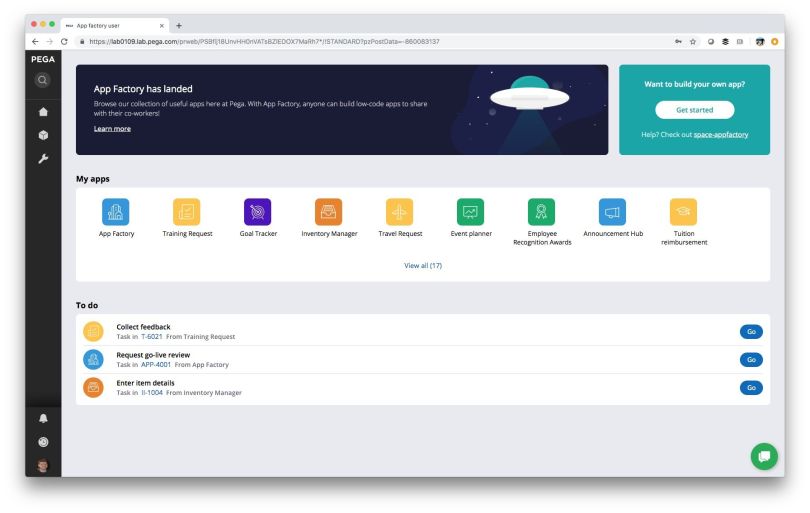Ask Google how to code more efficiently, and one of the first results is “Code faster: 53 tips from the pros.” Not one of those pros suggests working out of a low-code or no-code development platform.
That’s not surprising: though developers are always looking for ways to be more productive, doing more by coding less — or not at all — still sounds counterintuitive.
“With seasoned developers, there’s a little bit of a stigma to go with a low-code platform,” said Jennifer Gill, who’s the senior marketing director at Cambridge-based Pegasystems, which operates in the space. “But once they see the value, once they see how much faster and more productive they can be with a low-code platform, I think you’ll see those more seasoned developers turn the corner.”
In a low-code development environment, applications are built by dragging and dropping pre-existing blocks of code, leaving engineers with only the more complex or specialized aspects of an application. No-code platforms offer a similar experience, but as the name suggests, there’s zero coding required. These types of platforms are designed primarily to give “citizen developers” — or tech-savvy but non-technical workers — the ability to create apps on their own.
“The lay of the land is that developers are seeing low-code is the future,” said Anthony Abdulla, Pegasystem’s director of product marketing. “As they become more comfortable, they’re going to see no-code is even better.”
To be sure, Pegasystems has gone all-in on low-code and no-code development. The company has integrated both types of development platforms into its suite of software solutions, used by companies like American Express, Heineken and Sprint.
The lay of the land is that developers are seeing low code is the future.
So, while Pegasystems has much to gain by evangelizing this message, research suggests that these technologies are indeed taking root: Research firm Gartner estimates that by 2024, low-code platforms will be responsible for over 65 percent of application development activity at enterprise companies. According to Pegasystems, these new development platforms will change much more than just the way apps are built.
More Time to “Do More”
Doing more by coding less isn’t exactly a revolutionary concept. Model-driven engineering first appeared in the 1980s, and Microsoft launched Visual Basic, a low-code platform with a drag-and-drop interface, all the way back in 1991. Then, of course, there’s open-source software, which pre-dates model-driven engineering and enables developers to work more efficiently by copying and pasting free-to-use code.
All this begs the question: Why does Pegasystems believe that a decades-old concept is the future of software development?
The answer, they say, is pretty simple. By spending less time fielding requests for applications from across the business, developers can devote more of their days to important projects.
Take Pegasystem’s Enterprise Low-Code Factory, whose templates, documents and support content give Tom from finance the ability to build his own expense reporting app. Gill said that other than setting the guardrails — which ensures apps built in the product are compliant with a company’s best practices — the tech team’s involvement is often limited to coaching and final approvals.

In addition to taking smaller projects off the plates of developers, low-code and no-code platforms can also automate some of the more tedious parts of the development process. So, along with dragging and dropping blocks of SQL, Java and C++, Pega’s low-code platform also features drag-and-drop integrations, APIs and tests.
Increased automation during development is one of the key principles of DevOps, which enterprise companies are increasingly adopting to speed up the development cycle. While no-code and low-code platforms by no means replace existing DevOps tools, Sid Misra, Head of Partner Ecosystem Strategy at Pegasystems, told SourceForge they can act as a complement.
“No-code empowers organizations already using DevOps,” Misra said. “A no-code environment makes it easy to leverage popular third-party industry tools. Developers can easily integrate to Jenkins and Gradle for automation management, JFrog Artifactory and Git for code repositories, and a variety of testing tools, including JUnit and Selenium.”
Low-Code, High Impact
The true potential of low-code and no-code platforms lies in their versatility. In addition to making it easier for citizen developers like our friend Tom to create team-specific apps that streamline cumbersome processes, these platforms also aim to give developers the ability to build complex, customer-facing software.
“We actually use our own low-code development capabilities to build most aspects of our software,” said Dennis Grady, a senior director of product development with the company. “Our customer service, marketing and sales automation products, and all of our industry applications, are built using the low-code Pega Platform.”
While it’s natural for Pega to eat its own dog food, Abdulla said it’s not the only company that has built such software through low-code development. One of the banks Pega works with manages its entire credit card dispute process using low-code applications. Anyone who has ever fought a credit card charge knows how complex that process can be. There are a variety of ways to collect data (over the phone, through an online form, via app), and all that information needs safeguarding.
Low code and no code are power tools. They're not application development-light tools.
Building out the applications needed to run such a complex process requires collaboration between multiple departments. The idea is that, when you strip away the code and complex technical terminology, more people can contribute to the development process. With a visual model, it can be easier to see how an app works (or doesn’t) and provide feedback in real-time.
“Low-code and no-code are power tools,” said Abdulla. “They’re not application development-light tools. You can do full-featured applications for complex builds as confidently as you could with a coding tool and as rich and robust as you could with a coding tool.”




